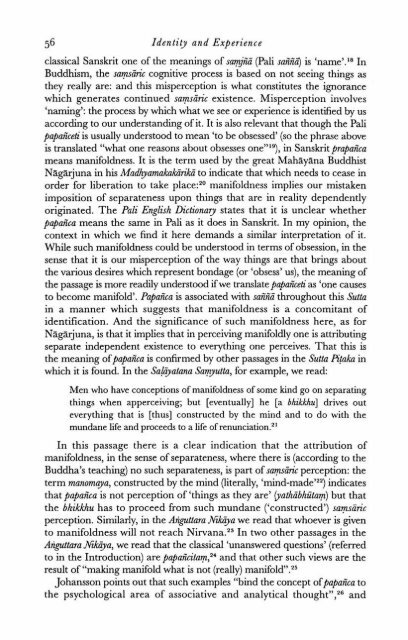Identity and Experience_Hamilton_1996
Identity and Experience_Hamilton_1996
Identity and Experience_Hamilton_1996
Create successful ePaper yourself
Turn your PDF publications into a flip-book with our unique Google optimized e-Paper software.
56 <strong>Identity</strong> <strong>and</strong> <strong>Experience</strong><br />
classical Sanskrit one of the meanings of samjzii (Pali san"n"9 is 'name'.'* In<br />
Buddhism, the sapiiric cognitive process is based on not seeing things as<br />
they really are: <strong>and</strong> this rnisperception is what constitutes the ignorance<br />
which generates continued samsiiric existence. Misperception involves<br />
'naming': the process by which what we see or experience is identified by us<br />
according to our underst<strong>and</strong>ing of it. It is also relevant that though the Pali<br />
papazceti is usually understood to mean 'to be obsessed' (so the phrase above<br />
is translated "what one reasons about obsesses onenL9), in Sanskrit prapaiica<br />
means manifoldness. It is the term used by the great Mahayana Buddhist<br />
N~ejuna in his Madhyamakukiih- to indicate that which needs to cease in<br />
order for liberation to take place:20 manifoldness implies our mistaken<br />
imposition of separateness upon things that are in reality dependently<br />
originated. The Pali English Dictionary states that it is unclear whether<br />
papaiica means the same in Pali as it does in Sanskrit. In my opinion, the<br />
context in which we find it here dem<strong>and</strong>s a similar interpretation of it.<br />
While such manifoldness could be understood in terms of obsession, in the<br />
sense that it is our misperception of the way things are that brings about<br />
the various desires which represent bondage (or 'obsess' us), the meaning of<br />
the passage is more readily understood if we translate papaiiceti as 'one causes<br />
to become manifold'. Papafca is associated with saiiiiii throughout this Sutta<br />
in a manner which suggests that manifoldness is a concomitant of<br />
identification. And the significance of such manifoldness here, as for<br />
Nagarjuna, is that it implies that in perceiving manifoldly one is attributing<br />
separate independent existence to everything one perceives. That this is<br />
the meaning ofpapaiica is confirmed by other passages in the Sutta Maka in<br />
which it is found. In the Safiyatana Samyutta, for example, we read:<br />
Men who have conceptions of manifoldness of some kind go on separating<br />
things when apperceiving; but [eventually] he [a bhikkhu] drives out<br />
everything that is [thus] constructed by the mind <strong>and</strong> to do with the<br />
mundane life <strong>and</strong> proceeds to a life of ren~nciation.~~<br />
In this passage there is a clear indication that the attribution of<br />
manifoldness, in the sense of separateness, where there is (according to the<br />
Buddha's teaching) no such separateness, is part of samsiiric perception: the<br />
term rnanomaya, constructed by the mind (literally,'mind-madeyz2)<br />
indicates<br />
that papalica is not perception of 'things as they are' lyathibhitam) but that<br />
the bhikkhu has to proceed from such mundane ('constructed') samsiiric<br />
perception. Similarly, in the Aettara Nikiiia we read that whoever is given<br />
to manifoldness will not reach Nirvana.23 In two other passages in the<br />
Ariguttara Nikiya, we read that the classical 'unanswered questions' (referred<br />
to in the Introduction) are papaii~itam,~~ <strong>and</strong> that other such views are the<br />
result of "making manifold what is not (really) manifold".25<br />
Johansson points out that such examples "bind the concept ofpapaiica to<br />
the psychological area of associative <strong>and</strong> analytical tho~ght",~~ <strong>and</strong>


